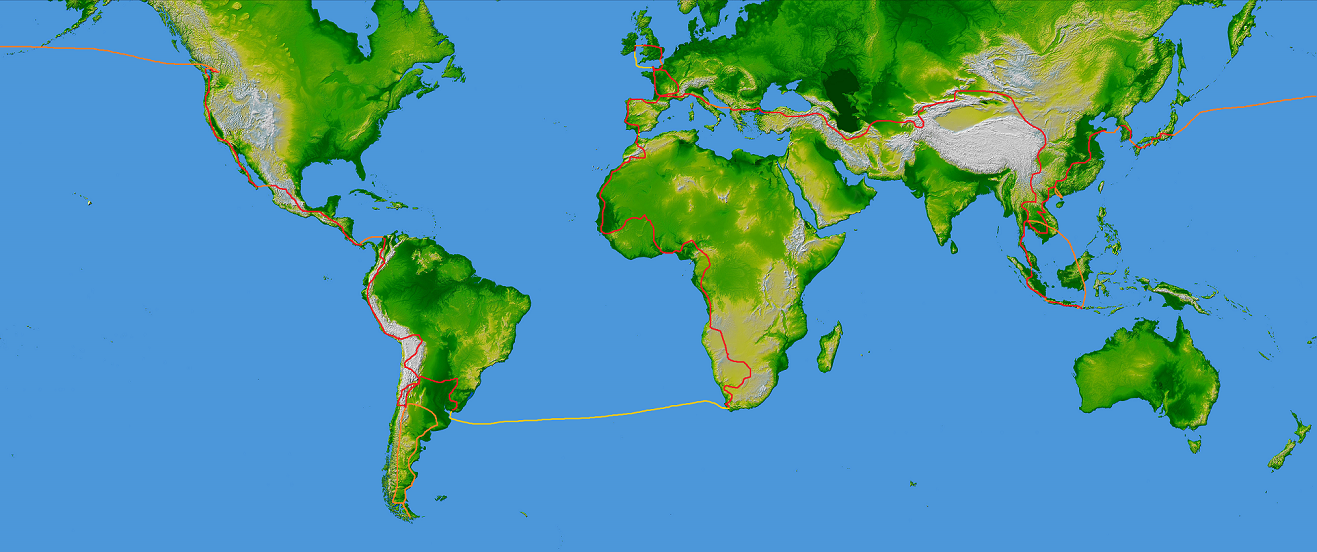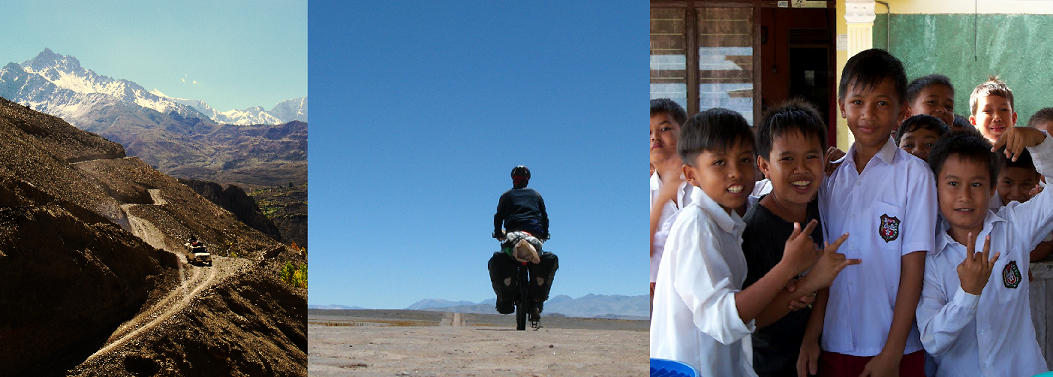Ellie donned her headscarf and long-sleeved shirt in the simmering afternoon heat of the Sarakhs border post between Turkmenistan and Iran. The old Soviet era fences that sealed the communist bloc from its southern Islamic neighbour still stand. A long line of trucks waited on either side of the border. Most moving back and forth between Turkey and the Turkic speaking countries of Central Asia. Most of the truck drivers smiled bemusedly as we pedalled off to the Iran side.
After our three day desert marathon across Turkmenistan Ellie wasn't long in falling asleep in the comfortable, air-conditioned passenger hall on the Iran side. As her 'husband' I got to do the serious business of talking to the immigration officer of our planned itinerary for Iran. He gently admonished a couple of Asian backpackers about their shorts.
After the friendly customs officer did a cursory inspection of one pannier and highlighted the local historical sites on my map, we met our bionic friend
Neil outside. We'd crossed into Turkmenistan together but Neil's pace wasn 't one we could replicate. He would go on to cross the 2000 km across northern Iran to the Turkish border in two weeks. We shared a room in one of the few hotels in town, became millionaires at the local exchange office and after dinner were pulled aside by the police until they established who we were.
As we entered Iran, the war in Syria and the chemical weapons attacks in particular were sparking debate in the US and parts of Europe about a military intervention. Iran, a staunch supporter of shia Syria, protested loudly against such threats and if a US-led intervention occured it wasn't clear how it would play out in Iran. I had images of street protests and flag burnings. Of course, just like the US and all other governments, the distinction between the people of Iran and their government is a distinct one that many people tried to show us on a daily basis during our time there. The recent election of the reformist President Rouhani though had sparked a small flame of hope and optimism that some changes, particularly in foreign policy, may be afoot, although with the real power lying with the Ayatollahs, there is concern that a rappoachment with the US and other Western governments may not be possible. The changes in the past few months are not merely for foreign policy either as young Iranians we met rejoiced in their newfound personal freedom that had not been possible to express under the previous administration of President Ahmadinejad. Being in public with any girl other than your sister or immediate relative was not possible. Now the restrictions were much more relaxed they said and they could travel together. Another interesting trend is a resurgence in the interest of Persian culture and identity - in contrast with the Islamic/Arabic culture that many lament has supplanted Persian culture over the past several hundred years, right up to the present.
Our route through Iran followed the main road west across the desert and south of the Alborz mountain range from Mashhad to the capital of Tehran. The metropolis of 15 million inhabitants sat half-way along our 2000 km journey from the north east of the country to the Azeri-speaking northwest and our crossing point into Turkey at Bazargan. The first half of the journey was characterised by heat and tailwinds - with temperatures in the high 30s. Frequent roadside rest areas however offered a steady source of replenishment, not to mention all the Iranians who stopped numerous times every day to give us gifts of cold drinks, fruits and nuts and offers of a place to stay should we visit their home area. It was holiday time in Iran and the country was on the move. Large parks filled with tents every night in the towns along the desert highway as many families made their annual pilgrimmage to the holy city of Mashhad.
Our sleeping time in Iran was divided between camping, basic guesthouses and hotels and people I'd contacted through couchsurfing or warmshowers. In addition we stayed several times with the wonderful Red Crescent paramedics who manned the ambulance stations and rescue vehicles for the carnage that are Iranian highways. These guys work in 48 hour shifts and like Central America's firefighters, they have a legendary status among cyclists passing through the country. Located every 40 or 50 km along the highways, they offer respite, a floor to sleep on and often some dinner too. A mix of hardened vets and young students, the camaraderie was infectious and we really enjoyed our time with these guys. Unfortunately on the final night we stayed at a station, an accident happened a few kilometres back up the highway we'd ridden down and a man died as they cut him out of the car, adding another victim to Iran's reduced but still very deadly death toll of over 20,000 fatalities per year.
A few days into the country I began to have problems with a tendon behind my right knee, with a pain and stiffness and sometimes numbness that extended along the leg, including my lower back, feet etc. As rest days were infrequent it has taken weeks to get over and it seems to be every so slowly on the mend, with suggestions of an irritated nerve (sciatica?) being made by some. Occasional doses of ibuprofen help as does regular stretching but I'm still waiting for it to clear up completely.
Iran was also a time of catching up with old friends, including
Paul Lombard, whom we finally got to spend a couple of days cycling together with up Highway 2 before he did a detour into Iraqi Kurdistan. Our much faster Swiss friend, Christian, who we had met with Paul in Bishkek a few months back was also in-country on his Africa Twin, bound for Pakistan and India and we had a couple of nights together in Tabriz and explored Tabriz's famous bazaar together. On the road to the Turkish border we began to meet a steady stream of cyclists heading in the opposite direction, many on the beginning of multi-year trips. It's fascinating to meet people who are starting out and adjusting to life on the road. One other character we met was German Hans. At 73 he's completing his multi-stage world tour (including kayaking as well as cycling). We watched in astonishment as the bronzed and white-haired veteran pulled up on his simple bicycle with just a small bag the size of one of my front panniers strapped to his rack. Inside, he said, was a tent, a sleeping bag and food. We looked at our over-loaded mounts and all felt like we'd a lot still to learn.
Our time in Iran was full of incredible experiences that usually emanated from the amazing acts of generousity that one receives when travelling there. On the other hand, I often felt like a crew member of the Apollo space missions when they go out of radio contact on the dark side of the moon. With
the ransacked British embassy now closed since 2011, and the more recent closure of the Irish embassy in Tehran, any loss of our passports would have created a lot of problems. Foreign passports are a valuble commodity in isolated, sanctioned Iran and one of the more unsettling experiences occured when a car pulled over on the highway before Tehran and two men pretended to be police and wanted to see our documents. I'd heard of this happening before and we pedalled on and they gave up easily but it meant that every car that pulled over subsequently was treat suspiciously - even if all they wanted was a photo and to give some more presents! Shortly after leaving Tehran we had another encounter - this time with police in an unmarked car. Wary of anyone claiming to be police from our first encounter we turned around and pedalled back into the village we'd just passed through as the three burly fellows tailed us. We flagged down a passing police car and found out they were police or some form of government security officers and after getting our passports examined and photocopied at the local station we were back on the road.
Crossing the border into Turkey was less of a change than anticipated. The northeast region is quite religiously conservative and a stricter Islam still pervades. Our living costs have rocketed and are comparable with the rest of Europe. People are less curious but still offers of tea come from everyone by the roadside. A tendency to try and overcharge the foreigners is back after seeming quite absent in Iran. After a rest day in the Turkish border town of Dogubayazit, under the shadow of a snow-capped Mount Ararat, we pedalled on into the eastern Anatolian highlands which have seen some of the toughest weather conditions since southern China. We seem to have skipped autumn completely as we find ourselves in all our winter gear and with temperatures dropping to freezing at night. Snow began falling as we walked the streets of Erzurum this afternoon, resting after yesterday's mentally tiring ride with an incredible headwind that saw us cover just over 50 km in four and a half hours. Europe isn't faraway now though, with just over 1200 km left to the Bosphorous and Istanbul. Ellie's brother Ben is joining us in a week for a fortnight of Turkish delight.
Erzurum, Turkey
Pedalled:
Many thanks for more donations to the Peter McVerry Trust! If you would like to make a donation, you can do so via my fundraising page on the mycharity.ie website (click here). Thank you!










































![[Image]](https://blogger.googleusercontent.com/img/b/R29vZ2xl/AVvXsEiDZX9Mdcs_xyFlHk0P172XfiLIWki4OdayZXeQXbwq_tx9pcemXVO6-67hgoXWs2TFiRfCqQgPtJzTzE9xgn6UYIBvjlDzYnbZ-1gg7aOlW1NIiPuF0GQpsYApVvLyUWtU4y3FCzD_6u0/s400/100_6461.JPG)
![[Image]](https://blogger.googleusercontent.com/img/b/R29vZ2xl/AVvXsEi8GCN79JonX0Hf8T0XHfA4KFRCdopb2IPoTW_B9knxVGNw2BITY52sIm9i2f2hPuw_S4IikJEOoF0c1KDko5FMqtktJXRqZeiXL2f2TUQrFBoZpJ-yfGU6fjWIaO-TrSbmT7yrd3Yrci4/s400/100_6463.JPG)
![[Image]](https://blogger.googleusercontent.com/img/b/R29vZ2xl/AVvXsEjcmKwZutwbdGh09HDLhG8FttsiOE5WitarRy_NxrvgX1pV_Kt9Jh9pQxYv851jDb80RsHjrdC_lJnKXQ-sCIBeW-rCnlDt-VUBvTPRxgSfR_yTDmkQxvWdYPgS3hdRoL2zUfJyPG_EmdQ/s400/100_6466.JPG)
![[Image]](https://blogger.googleusercontent.com/img/b/R29vZ2xl/AVvXsEiHsM6tfRa2GNBLhF2bzoalgKlR9Wo7qBDpaXSK1_GVRJ2xYYLVJhYluBpemHq93oM_cpwb2lkJxldhgqjwvhDZEGaqv-YatwVKLcShgO82nzYoSKavPofRzoma35q7mto-BgLImP2cjt4/s400/100_6487.JPG)
![[Image]](https://blogger.googleusercontent.com/img/b/R29vZ2xl/AVvXsEguaF988YnbyBu6Y9NHdvbRgN0gsa7uaHLVIw_wJlOn1oV1rReoqbmfdhSj7cvJm1zBRyni395xeZL4TzGb1fQXV8C4gh-WYd7aCxJMsab_G-BCTOegjPyJ7o5jVxLGJeGt8LsrkPrN-DA/s400/100_6490.JPG)
![[Image]](https://blogger.googleusercontent.com/img/b/R29vZ2xl/AVvXsEiye818ALb6TGkISzjhS5JzAw-dm4C7qmaHmX3M1jm08fbm4OsiWAzmkV8QYzvpXXGhkXuiM2QjciCJT4TesScEiAJPNJgVEZJaA2uRLfVphptcVDmUEkKdkBmG0GPwlo2SFyC8EbiNyKQ/s400/100_6491.JPG)
![[Image]](https://blogger.googleusercontent.com/img/b/R29vZ2xl/AVvXsEhXk9nBNYqecW41S9G6s1HThB8YmWB7NhI9R28YeUBVY6z97gTJbOzmM8Ojrqt6Y_6Se80GaHA6T8jbCE3LQjhJ7d8HRAL2zAz5-FzchW1CZ7mt765m6Ulakkqntpu3h408y1t-kQGvhDI/s400/100_6500.JPG)
![[Image]](https://blogger.googleusercontent.com/img/b/R29vZ2xl/AVvXsEj7jbVo9OEUZ3-oJbeYRhXH_b8pFI6D-wcqCyk9lDfN2Ox2jEHfb3JcDw4wkzXFqPhsTv3ownm8y5fwtmmft-s9D3ejlHP7rUmhBHWxHcOL5rIGzbn0dz5DXA0hWbdgxIPQvc7dx6aoVc4/s400/100_6501.JPG)
![[Image]](https://blogger.googleusercontent.com/img/b/R29vZ2xl/AVvXsEhhZ_MY2eqyDi8YGb890xzsswBRMt6zSL9x4VBv0MlfM2WRFsfiqrbSLauj0nXyVHCFmbFFOzohP021kYdmLrbFpe6XZL1r88hCJwB7ihlg8jPyIF89czxCBIj3NJnc8e8ovD5bMz7soN0/s400/100_6505.JPG)
![[Image]](https://blogger.googleusercontent.com/img/b/R29vZ2xl/AVvXsEitgnB9FBp52eZ1pFcx72kEIQWgHL9ExKAwHOLznvXDCmuxRJZDvUAegyImvZ3kD-YCtoiPr0mPdNDT6Y1CEE5IvFjRlEzole6ZT26sFoM-TbWY-AuosfzIkBm6In9s9_zrA7lE3_10ToI/s400/100_6506.JPG)
![[Image]](https://blogger.googleusercontent.com/img/b/R29vZ2xl/AVvXsEgs8pB2b70JsBC2TVTGvEmyfnLSRiofcTmtpDUkk4JoEwsKn8fL5uOUwiqstt0owWXS30h2D2KFbXveUM3_5jqOnPp_3YlIHU72wUHPWZkqr88Ntez3eOKbCNrUZCruS4hUeKW77mHHMcE/s400/100_6507.JPG)
![[Image]](https://blogger.googleusercontent.com/img/b/R29vZ2xl/AVvXsEgygcGyIplEd7fCl305nk00AWuC-PPulkyzy33gSk1xm6IjdhFWf66TgNnppRNafClQI0LRAN5PDVBT_mpfUob37fsk8qvPWKG1GMZcn_GwGN0k9uXqD7Ipo58qOXFyhgrDsYNBNoGDuAM/s400/100_6517.JPG)
![[Image]](https://blogger.googleusercontent.com/img/b/R29vZ2xl/AVvXsEie-RliRWU4X3m1p0qGS_NfbgiLuaVKa2VRsxvv67_yVRek91SYQc_2qKnISb4-F7XlhiRqPsYC1KpUyO_FOl2wDgGbQbXtkjpxhbya54JkgyinbUPGgMJfOg236Qjnie82aycCAG9iaXw/s400/100_6520.JPG)
![[Image]](https://blogger.googleusercontent.com/img/b/R29vZ2xl/AVvXsEgjd0IhNdLVP3Wdf8irhmUct5A74ejfE13vF1G-GVBnhF3TfWm7em0I_hJJ_WA4wJgyJMvYxOa8vAPwMu_ZSFpFliWs6xa2kGtRWo4LOWNQGg7kWmE5YPVECzsfDFo2Umk6bCcAnSennfE/s400/100_6524.JPG)
![[Image]](https://blogger.googleusercontent.com/img/b/R29vZ2xl/AVvXsEhpqJhd8qVyJ8FMXXB3f4A2xCiH_WeVxxhtPNrlSpfet9assh_gcNI6or96XYyiEMk47JuVa-bHfYNCzbKr8HA5Crd43pxrPLOgulJMPtnu4iTAcNIqdVgAOQYSm01XH74YAI3wuhV9v0k/s400/100_6525.JPG)
![[Image]](https://blogger.googleusercontent.com/img/b/R29vZ2xl/AVvXsEgXzKUcukWEAfFRoUQMZOSGmGgIRZ4jf61p0z_2wTADdk4o7sabTP94iuahXGo6tqeDxzQdjziLIgwvDPwSGZtiursQgNZ5fuFIEA7lNKWjNZs0nfkxPGi3QR000dIF3gdZT2IAF-fuCfs/s400/100_6529.JPG)
![[Image]](https://blogger.googleusercontent.com/img/b/R29vZ2xl/AVvXsEisDwYYI9eSJh1HPhxN3J9ApB3frj60Btt8mL0rVPbaft-_p7W5xD12P_hLvsslB9FcpnUYvIL0ahjbldcBzSbwcGt5KHdl6xiFkonR2of7FW7wzMKNsWL9o2shX938yHWYUCx_YJ16ZBo/s400/100_6531.JPG)
![[Image]](https://blogger.googleusercontent.com/img/b/R29vZ2xl/AVvXsEiY6W9mEDkb4axTWPmCaK0PNv5EV4Qzj8GNnwkyswd0s3I0eJhyphenhyphenxhMhkhly_SwzmFNqhRF4xmqj_zubXmBzJE8dJHkdh-BjBnlUtG1GsUmodV0JD2cSgCTIWF3KhBWcDqlCrOklCqOTqRQ/s400/100_6536.JPG)
![[Image]](https://blogger.googleusercontent.com/img/b/R29vZ2xl/AVvXsEgg3V33ICOt8LXU9_Affvp8HbCVkfdhnk9XjFMYXvy4MGMSQ7zQnahQmhVORcvFhOMRNxQbRABpBq5frQsaxCFTmgjG89lFjZmnAFyhxXRMjAjy9hXbls-VC1LkQVGKhvulXwhWGXR8DFI/s400/100_6538.JPG)
![[Image]](https://blogger.googleusercontent.com/img/b/R29vZ2xl/AVvXsEg0YYHX-Qxsq6O0sSUHFqloFrK0NfLu7OftrQDzXdR7cLBBcWyXr3buOy2TWkpZiZSp_MkK3vsaPM_FYtw_XoDdEiFaRbB8PaJBhMkzUIT_POJCFpqzlw15nupiM84HoKB45brHDXcYmx0/s400/100_6547.JPG)
![[Image]](https://blogger.googleusercontent.com/img/b/R29vZ2xl/AVvXsEhUIMvRl7iX-2yjSsas6_eJYwXtFiXRs5P0mAJfkUws_rBkeq2uutbsjgO2I09PvxeD13gS9jlLLPJw7W8KGgrr5X0U5WL8dQsXqIOXWcNFrS3sMHKF9XyMW1n2fLgMwB9ta61LVpiWTB4/s400/100_6564.JPG)
![[Image]](https://blogger.googleusercontent.com/img/b/R29vZ2xl/AVvXsEhkU75PUoGZEue9U8OEjKSF76dzTDmk7FYmlXxeACar4rMIcygk7AWPWkyuprj7HtKtuHkXl6nTjWvClTj5Bg1TIjPz0OtwZGse0_qWpD18l65LGBSrR78dNsAdqgtP5E_bnmE7psOYdzM/s400/100_6565.JPG)
![[Image]](https://blogger.googleusercontent.com/img/b/R29vZ2xl/AVvXsEhj5zYZ_6h_8O-pjZNRnn7nMzCnFT8dtCYf6gg23Rcpmtx97EUP3IwQ99sxIE2eSFZJzzGoy-fWHBfyZLszNzoij9wrU6dhX0CcaOdIC_1E_XDZBzQgb9w8gu2Iu3y24K7BYQmLQJ-FDcE/s400/100_6566.JPG)
![[Image]](https://blogger.googleusercontent.com/img/b/R29vZ2xl/AVvXsEiLTeqdz2IwpBrFytsWOKf-gt5tdGxFlGrGx6y9StUa2p8bKiQD28MVA-beO5v5Q8B365eg7AJZ94-JGDZzT1bXt_bf3T-ygg7rtlr2i62hdhhsEfTicvvASLGkhtgOcGutSC6BCJ3Xg3s/s400/100_6568.JPG)
![[Image]](https://blogger.googleusercontent.com/img/b/R29vZ2xl/AVvXsEirgNZ-Nxq5Wd9Am6RVyQOtxvTzHK3q09EMUX1u_n7tA7KvXef8XQdEZJVzpk2HCwDdSXnfFaHwi4BOSmQ17jajep-qwghCe87Cea5d0DiODejZuqZKKGWNwfuwWVOhBkqvncmUDalgLy8/s400/100_6569.JPG)
![[Image]](https://blogger.googleusercontent.com/img/b/R29vZ2xl/AVvXsEgaeR35ZOmHgE1uJ3F5hvIUdq8GuACQsqNkK4pjpC6GwajXJzG8vuBVbnOTxGH5Io_6aXnCbI0WKAZtMHcm9q0RVnq3aEZOlOBa3x7Rpe_xPhUbpvuCWhixDa2q4febA88oNwbftDTl2T8/s400/100_6574.JPG)
![[Image]](https://blogger.googleusercontent.com/img/b/R29vZ2xl/AVvXsEhohDslttZimxd6oTD1ft5aV88SxTogqySO8J3anq2og-jsp-8WS4DbmufHG8jx7iA09H9yJkosNdnOUT_KO32e_UIs01BwlsDSvqJB-v-BcZE9EvtGElLi6UtOLv2Xdg8QAfXFBFGFWhE/s400/100_6586.JPG)
![[Image]](https://blogger.googleusercontent.com/img/b/R29vZ2xl/AVvXsEi4n_0vzPf4BkcJ2z3tlWyRM9J1yR8hHw1s-pXG4dJY_2eguQGmKlaHSAMxh-OmJi3NFzwT1mX6jk5o2Jj3zWcxC1FzPVuD4ctcFmcJMULhbIQRf-QucZOsPp21aa8_ltzTX89lw7ms4RQ/s400/100_6589.JPG)
![[Image]](https://blogger.googleusercontent.com/img/b/R29vZ2xl/AVvXsEhaQ_vKHWfZrBwcxdJBtBuPrgouoLTIZ7T1rmp169C3MRGcBLXEEMAoR7CrGk6Oi9xXwaRsW1uBeLTQnDaSClLpYf-2Tig7GSSKyR9lUudID2P_TNwh_6AN4r4SZ2RkA9LJAtvfI1amze4/s400/100_6598.JPG)
![[Image]](https://blogger.googleusercontent.com/img/b/R29vZ2xl/AVvXsEhJcqS8OXH9wEYqAtoQ1JRwM2YlPZ3uGpuXQ1ivBW4e3R8v2gc5pOmeZ33LUGbl5qLBuREfEf2GdxoCoLKrtcpTvbnTtdF-5jIrFkMjt4KRFCr6r-HZoNjJ9aOwF23xFdH0MYDpYcRyOKA/s400/100_6605.JPG)
![[Image]](https://blogger.googleusercontent.com/img/b/R29vZ2xl/AVvXsEhrsTrafysObgFrxFqeMkMsDcuYhp-0DXyQ8ckWV36J7n0L3twkjOEQBKOVB7SXqxndnkkk2KDpVWS3dt753Mgy03dvch_6TscfPTY9G45MaGg8pMPZkMOTFh0cKtqI-111Rsa5ta0wTe8/s400/100_6609.JPG)
![[Image]](https://blogger.googleusercontent.com/img/b/R29vZ2xl/AVvXsEgS7RqaL-rmYoQVt68Szk9-Sax_KiJj5a0eaPNmxwFS-WBxsSRRpNxE2Gq3TaRfypEXqngxFH_3BxrpBWPyYRSFxx_bu7N6FFRAmifqAcWMIy3XrqLAH1AB_xnhUXpj7_RAB74G517-Xuc/s400/100_6612.JPG)
![[Image]](https://blogger.googleusercontent.com/img/b/R29vZ2xl/AVvXsEiT0_gmnvIFaOHQsGCxErPg1lnuH4mAN4nxA6Ob3cKfts4etowg6irXtmk-h_qiyoTu6IKLPH6J2cDsOeCssNDgDL1dM_KJst5rD27l_zu-yF1RT37iyUtKAZjDi4junlcxvNM75xBw71E/s400/100_6617.JPG)
![[Image]](https://blogger.googleusercontent.com/img/b/R29vZ2xl/AVvXsEg-Oj_FNLggYQEcInoIwPBupGXu3QmCdjcfYm1agy_ts8TU4fWwwOKG4qz3pQspyl0ibXxH5TJCML3j116IMDlgicpLZTJPI9DBqZ0O86q7di519jSV006Zjt7flHXtEKf-GY-A3IJ58e0/s400/100_6618.JPG)
![[Image]](https://blogger.googleusercontent.com/img/b/R29vZ2xl/AVvXsEjir20-bDZEOc66btUb-zG-1oietaPElJeoCAvU-hR670c9um6Av7QqQYlgZe4nzo4OVRtVISAcVaDaZyOiRvyuGX9R2ALG284XQUXziUYq32UZrJifIICovIPKwLAgHc1RqKGuJGO6ej0/s400/100_6621.JPG)
![[Image]](https://blogger.googleusercontent.com/img/b/R29vZ2xl/AVvXsEhj7FZOlDiHztL-mRlTZ53U2XOEGaYdE6OjNQ9I81L3KkxxkPm_t3qd4QP7JH4BRT3hB-nQnVem_-Nq8HyldT1vUM7xNYrgrrwVemXxqFXRLjPKC3pvxzr9kL035zDl2V9kwQXfjPi4gAQ/s400/100_6622.JPG)
![[Image]](https://blogger.googleusercontent.com/img/b/R29vZ2xl/AVvXsEjDDPjIoL7QWzJMu-uSz7LjZWP2vIjwV4HNvpf5QeY8pGWjegQvJuZmPBuFt4JgmqEBn7W9QRpFYUBzICutw1B-1Oibj5ipQNmHHwUsXH42LEHCGIREyLj77fTmZozWDdPxEn16wcFJL_g/s400/100_6623.JPG)
![[Image]](https://blogger.googleusercontent.com/img/b/R29vZ2xl/AVvXsEgeI9f2kiNOLsrrswcNzNSmhFIU-bCPFWehCfXFDalDRLp2TliFTf51JTnHefZNSsQHpsFpyiYZQBnUHaLWbO1O95s68gRlDeg9_h0D1xj7o4ymCdjvj6F2zJDrWmW4d8YRfQkijHnFQxI/s400/100_6625.JPG)
![[Image]](https://blogger.googleusercontent.com/img/b/R29vZ2xl/AVvXsEj9Y2I70jYEQSrHJla01diuiTIgQMk1jMh7GVHJNXqc0kd1879Id9tbd5VZNAIXHSoGWpY3w8o4RxEqny7Q-4CGkAouM0CYTZI0SiQeqXp2XzclncL2YxZDDf7AwJP6poDt4_DD40NDBh8/s400/100_6639.JPG)
![[Image]](https://blogger.googleusercontent.com/img/b/R29vZ2xl/AVvXsEg7_yr6H5v31W8jlRKD0pEeapJ_rnhgDT5nrOvv_4dw-XWKd71_WwtOqMCUdbWWHDYV7TRV0tNhRuki1tWvGqSMmjtSp5K-qSvtS6dvdRB7eqqWbO_fFQHlS4NwOVMLU55ypvWf361BRDs/s400/100_6642.JPG)
![[Image]](https://blogger.googleusercontent.com/img/b/R29vZ2xl/AVvXsEgzR5wkD5qbz5lt0AozqNHo0Cm1IzzxGYdQpxLG0TTBWh3L_OXocUrCcbnYABAUXaAdkuE6Nlf5caLeOwjke0DpszFrPMuQ-tMkli2RQQyvRgcY4RT4Y932JMA0dy3PzslbDlOY6mVR0S8/s400/100_6644.JPG)
![[Image]](https://blogger.googleusercontent.com/img/b/R29vZ2xl/AVvXsEixcMCnB0PgI3Z_6HyMIgIY3LmUZv7Gpy1G_UeGUi4DoRuyPYMolN1yEyvpCFgeXn4ye98bWdE7cmSvU7gqUGBSYjxE-EBg80HbSdTz_1-USup1yB0qF2UcXXwBJZ7wZHZarez1JLHd8wo/s400/100_6645.JPG)
![[Image]](https://blogger.googleusercontent.com/img/b/R29vZ2xl/AVvXsEjyP9pAx_lrCj4TW79hq4jPOHi6hqpSlOfCkenwU_cTDch4qCkfHBhyqvw3i62IJ781KlBSLjt3pDjCY-S4rn99q0-Dv6Fw2gPKKVEifH1PLInlralWIliB_Q6N77IJXEVI2rT-r_XC7ng/s400/100_6647.JPG)
![[Image]](https://blogger.googleusercontent.com/img/b/R29vZ2xl/AVvXsEgDig6WvysCT9qIvwRgRmHrUTzzzM2gPmzNUKvj6_5VOAwiLYO3Lnv9vRD1cU4hJd6ZmQblZz_yeHWmcur5c8HjIdXZDjxAJb0sZ2k5N4DQPm-vUgS6Ng3skB0lxB4SiaVIgg9f3h4i9Xg/s400/100_6650.JPG)
![[Image]](https://blogger.googleusercontent.com/img/b/R29vZ2xl/AVvXsEje4ob8EVlyu8_bCVJPcr3avSfRZWfd6lEYBBjDLD3L9rJ5fCkkr60B-DjDoNlDoXB5KpNgM27goAQa9vYXgv25uYw48m0c2fJ_gh1EL-YQ0owo819vr0b6m_nTtjFYCgUga4Xtmrk-4Pk/s400/100_6651.JPG)
![[Image]](https://blogger.googleusercontent.com/img/b/R29vZ2xl/AVvXsEh9sDQFUl9QTQF6d3how-3nYWdA2YWKAo_KY7_o2tQOOVv45sf4n3jJuQi7r9iWiqr-0vr5zcZtz9gTr4U8dxNHvMpAEHltk-olHXYfTXpqfiXfzjgbLLEaL-Yk_tNORBajGITjVauorYE/s400/100_6652.JPG)
![[Image]](https://blogger.googleusercontent.com/img/b/R29vZ2xl/AVvXsEgF0QnLZ13ubjNZmdF0OlP7_BH43RMgPeZ9vrkyUxkMs4YpRfEynExUe2cfIc5xfc9uejdnrGk19eeWI1WgBa5xXNFLwMISTUj37TTFV0tZ1pGsc7AHVmLlSIVlA0ohy9EN0Zc4GImNdvA/s400/100_6653.JPG)
![[Image]](https://blogger.googleusercontent.com/img/b/R29vZ2xl/AVvXsEgrbYvjJcfIEOI-QbpZzDf73CXBeh1_sYADwNHp72q_oR2IKqXiMZon2GCBkCivMZueg46puO70g9u1hnK0sp9aiW3n6dLmRUhEGIGMyp_ilREIbHPCOYRUXgmkChElVXZ7s27jNGJRG0g/s400/100_6657.JPG)
![[Image]](https://blogger.googleusercontent.com/img/b/R29vZ2xl/AVvXsEhmFFwgNUer_Y1UB52e25cimFldvqbjvBfgC6HgeEfD03x8iHTCvMg2VV7CYj3rw9x4GOj5-HNXEVfPkzpR0pPQd0kLjtouqer3ym2nehQaflSOOEiclppYNbUhLj00SqKlpAVXUImX7jQ/s400/100_6660.JPG)
![[Image]](https://blogger.googleusercontent.com/img/b/R29vZ2xl/AVvXsEhN4Mocsop5JwtzqE4AGpdYjAu1V8bLgSryESUWluo7yO15rBGhVIFjqxwS4_BNV7EMEw15Oi-pdvFEDoHpT8UTK_gBwoB8PFdBIUIx7aInRFp8G_Roi8-tkIo0WRK6THlhZlkbcq1Y3Og/s400/100_6666.JPG)
![[Image]](https://blogger.googleusercontent.com/img/b/R29vZ2xl/AVvXsEi4oP4DGM4VPKO9IcuU3macPOD3B2mmPlYr84ZzYD-essnkgBeEC_wI8ueA9gYVmHtmKH2DQYkVt5PIUzeQDRMVWNs15zoTsTZKDJpKbtnnIkULkmoIKroNI4qWpV97Ifn0i8fmohuKEo0/s400/100_6667.JPG)
![[Image]](https://blogger.googleusercontent.com/img/b/R29vZ2xl/AVvXsEiTT3tUIRZRnzk7weSDoE-cABuZcJ03lc7g8TtXX110iWKmvkSviEBsGBm_bX3QR6Jckg0f2MqQlYP4JZm7Owcn6qoN7G5QEIIkYPMnYZfyIZ5iRQn76Upc4E_nAjjWGL9SOZh4I1ibemM/s400/100_6671.JPG)